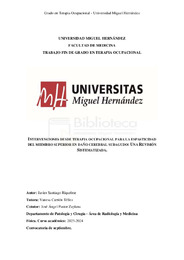Resumen :
La espasticidad del miembro superior es una de las principales causas de dependencia y
pérdida de funcionalidad en las personas que han sufrido daño cerebral adquirido (DCA),
además, se ha detectado un aumento de los casos de DCA, principalmente ictus en las
últimas décadas lo cual agrava todavía más este problema de salud. El tratamiento
temprano de esta enfermedad podría ayudar a las personas a recuperar parcialmente sus
funciones. El objetivo principal de este trabajo es revisar la evidencia científica acerca de
los tratamientos empleados desde terapia ocupacional para la reducción de la espasticidad
en DCA subagudo. Se realizó una búsqueda sistemática a través de las bases de datos
Pubmed, Science Direct, Scielo, OTSeeker, Dialnet y Cochrane. Se escogieron aquellos
artículos entre 2014 y 2024, en español o inglés, que trataran la espasticidad del MS en
fase subaguda de forma específica, evaluándola y sin recurrir a terapias invasivas o
exclusivamente farmacológica. Tras la búsqueda se encontraron 41 artículos sobre
diferentes tratamientos entre los que destaca por número de artículos la terapia con robots,
la estimulación eléctrica transcraneal (tDCS), la terapia en espejo y el uso de realidad
virtual (RV) y videojuegos. La terapia magnética transcraneal, la tDCS, terapia robótica
y terapia de ondas de choque sugieren tener resultados prometedores, sin embargo, los
resultados generales son inconclusos. Se requiere de una mayor investigación para sacar
conclusiones definitivas.
The spasticity of the upper limb is one of the main causes of dependency and loss of
functionality in people who have suffered acquired brain injury (ABI). Additionally, there
has been an increase in ABI cases, primarily strokes, in recent decades, which further
exacerbates this health issue. Early treatment of this condition could help individuals
partially recover their functions. The main objective of this paper is to review the
scientific evidence on treatments used in occupational therapy to reduce spasticity in
subacute ABI. A systematic search was conducted through the databases PubMed,
Science Direct, Scielo, OTSeeker, Dialnet, and Cochrane. Articles from 2014 to 2024, in
Spanish or English, that specifically addressed upper limb spasticity in the subacute
phase, evaluated it, and did not rely on invasive or exclusively pharmacological therapies
were selected. After the search, 41 articles on various treatments were found, with robotic
therapy, transcranial electrical stimulation (tDCS), mirror therapy, and the use of virtual
reality (VR) and video games standing out due to the number of studies. Transcranial
magnetic therapy, tDCS, robotic therapy, and shockwave therapy suggest promising
results, but overall findings are inconclusive. Further research is needed to draw definitive
conclusions.
|
 La licencia se describe como: Atribución-NonComercial-NoDerivada 4.0 Internacional.
La licencia se describe como: Atribución-NonComercial-NoDerivada 4.0 Internacional.
.png)
